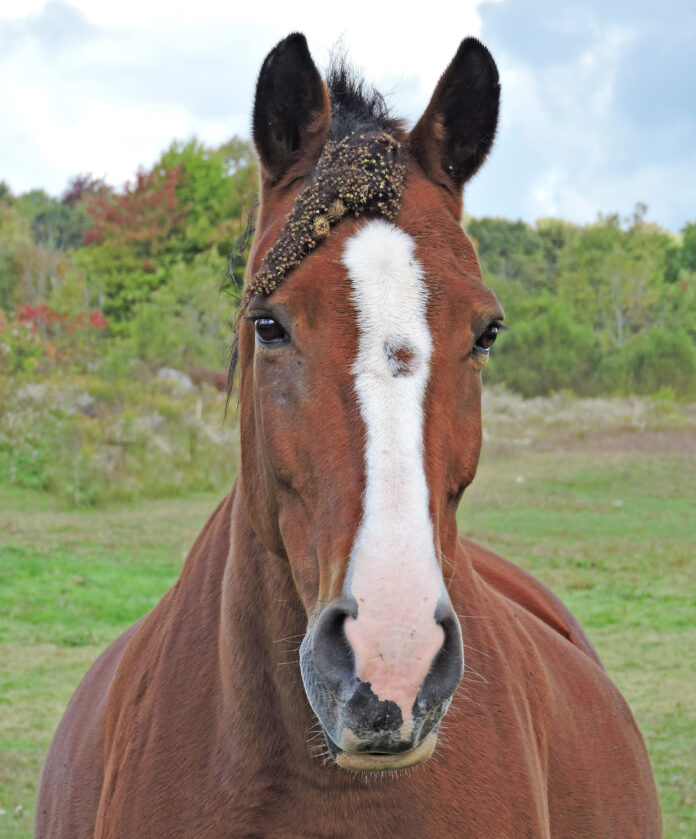
One of the greatest advantages of living in a rural area is the network of rudimentary roads that weave their way through the countryside. Personally, there is no better way that I know of to unwind than to get lost on these roads while taking in the sights, smells and sounds of the changing seasons.
Recently, while on a leisurely drive along these very roads of southeastern Geauga County in Ohio, I passed a handsome horse gazing at me across the fence. So attractive was he, that I decided to reverse my vehicle and snap a few photos. That’s when I noticed his forelock and just had to chuckle.
Autumn is a time when many plants go to seed and each species has its own method of dispersing these seeds to give them the best opportunity to germinate the following year. Many flowers produce seeds that are spread by the wind.
Traveling by wind
Milkweed pods have seeds equipped with their own flossy parachutes which allow them to sail far and away to establish new patches in neighboring meadows. Milkweed, of which there are many different species, is critically important to monarch butterflies, whose population continues in a dangerous downward trend. It is the only plant on which they lay their eggs and the fragrant blossoms provide nectar for a host of pollinators.
Relying on wildlife
Hickory nuts, acorns and beech nuts are mast crops that provide wildlife with a much-needed supply of food on which to fatten up or store for the winter. Squirrels, who spend most of the season burying these nuts for future winter snacks, can’t possibly remember where they hid them all. These forgotten seeds are inevitably “planted” and will grow into future trees.
Winterberry, poison ivy and wild grape are a few of our native plants that produce berry crops so important to migrating birds. Many berries are brightly colored in the hopes that birds will notice and ingest them. As they fly and digest, the seeds within eventually exit the birds’ bodies, some of which land in spots with favorable conditions for growth.
Hitchhikers
Yet there is no form of seed dispersal more efficient than that of the hitchhikers, otherwise known as burrs. Have you ever emerged from a meadow stroll to find your pant legs covered with tiny, prickly balls? As you walk along, pulling them off, throwing them left and right, you are conveniently dispersing these seeds.
How many times have you run a hand over your devoted dog, only to feel their coat interrupted by masses of immovable burrs? As you brush them out, discarding them here and there, you are spreading them and ensuring the plant’s survival.
Most wild mammals collect these hitchhikers as they forage for food. I have seen many a white-tailed deer pulling burrs from its fur and raccoons at the feeders sporting seeds in their thick winter pelage.
Burdock

One of our most obvious burrs comes from a plant called burdock (Arctium sp.). By mid-summer, this plant with its large, broad leaves can be seen in bloom. Large, bristly, purple flowers are a favorite of honey bees and other pollinators which take advantage of the nectar they produce. But in the autumn, the blossoms fade and the structure turns brown and brittle.
Have you ever looked closely at a burdock seed? One can’t help but admire the amazing system of hooked barbs which have evolved to grab onto anything that comes in contact with them. In fact, in the early 1940s, Swiss inventor, George De Mestral took burdock burs from his dog’s fur and examined them under a microscope. This led to his invention of Velcro, a necessary commodity in our everyday lives.
Agrimony

Beginning in June, agrimony (Agrimonia sp.) begins to flower. These plants, also known as cockleburs or sticklewort, send up long spikes resembling steeples that host delicate, five-petaled yellow flowers. It is amazing how many pollinators are attracted to these diminutive blossoms, the weight of the bumblebees gently bending the plants downward during pollination.
As each flower becomes pollinated, a seed begins to develop, becoming brownish-red and woody in texture, topped off with a ring of hooked bristles. The knee-high plants are now ready to distribute their seeds to anything that may be strolling through a field or pasture and brush against them.
Beggar-ticks

Two other types of hitchhikers bear mention, beggar-ticks and tick trefoil. Also known as sticktights, common beggar-tick (Bidens fondosa) is in the aster family and grows nearly 4 feet in height. The plant has loads of serrated, compound leaves and sends up several flower heads on each stem.
Lacking any petals, they are far from showy. Once pollinated, the flat, dark brown seeds with their dual hooks latch onto anything that comes in contact with them.
Tick-trefoil
Tick-trefoil (Desmodium sp.), also known as tick clover, is a member of the legume family and sports deceptively, pretty pink flowers. Low-growing, the plant is rather inconspicuous until its seeds begin dispersing.
These flattened segments, each containing its own seed, are covered with tiny hooks which give anyone a challenge in prying them off clothing.
Again, I giggle at the equine’s forelock, packed tightly with agrimony and burdock burrs. Whether someone takes the time to remove these one at a time or simply decides to get out the scissors, the seeds will prevail and some of them will thrive where they land to ensure new growth and another crop of bothersome burrs next autumn.













this is so cool